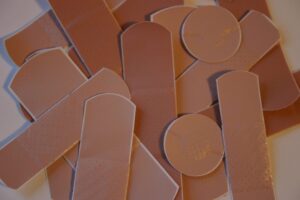 I have known I was allergic to the adhesive on some band aids for years. Applying the wrong type of band aid would leave me with dihydritic eczema if applied on my hands, and horrible itchiness and red, bumpy rashes if applied anywhere else. The rash took weeks to go away completely, and my topical steroid cream did nothing. I would always be asked if the problem was latex, and I’d have to say no, because condoms didn’t affect me, but I never could figure out what chemical caused the problems. Usually the ones labelled “latex-free” or “hypoallergenic” would be safe, even though I knew latex wasn’t the cause. This is really annoying, because the majority of cheap first air kits found in the places we normally go contain plastic or fabric Band-Aids. Now that I know isothiazolinones are found in some latex adhesives, it makes a lot more sense. I also have a nasty colophony allergy (worse than MI). What else can be found in bandage adhesive? Take a guess.
I have known I was allergic to the adhesive on some band aids for years. Applying the wrong type of band aid would leave me with dihydritic eczema if applied on my hands, and horrible itchiness and red, bumpy rashes if applied anywhere else. The rash took weeks to go away completely, and my topical steroid cream did nothing. I would always be asked if the problem was latex, and I’d have to say no, because condoms didn’t affect me, but I never could figure out what chemical caused the problems. Usually the ones labelled “latex-free” or “hypoallergenic” would be safe, even though I knew latex wasn’t the cause. This is really annoying, because the majority of cheap first air kits found in the places we normally go contain plastic or fabric Band-Aids. Now that I know isothiazolinones are found in some latex adhesives, it makes a lot more sense. I also have a nasty colophony allergy (worse than MI). What else can be found in bandage adhesive? Take a guess.
The Worst Offenders
- Fabric-backed bandages
- Pink/beige plastic bandages
- Possibly plastic tape
- Some physiotherapy tapes
The Good (for me)
- Paper tape
- “Flexible Foam” bandages
- Clear plastic film bandages (like the “tattoo” ones for kids)
- White hockey tape, at least the kinds I’ve encountered
- Flexible sticky wrap that only sticks to itself, like the kind used to hold gauze onto your furry pets
Stopping bleeding is important, but being afflicted with a nasty, itchy rash for weeks afterward is not worth it for small injuries, and avoidable for big ones requiring heavy bandaging/gauze. What to do?

By Pearson Scott Foresman
Important!!!!
If an injury is very dangerous or life-threatening, treat it however you have to to keep yourself or the other person alive. Having a rash is better than dying or losing a limb or any other part of your body.
Otherwise:
- Keep note of what kinds of bandages you’ve used in the past and reacted to. Avoid them in the future.
- When you’re injured, strongly consider if you need a bandage or not. If you can apply pressure for a few minutes and completely stop the bleeding, maybe a bandage isn’t necessary. Consider carrying cotton balls for these kinds of situations.
- Try wrapping the injury with gauze or a gauze pad and using tape around the bandage only, avoiding your skin.
- If you find an adhesive tape you can use, carry it around with you for emergencies. Foam bandage backing is sold as tape, as is paper. Gauze is usually readily available in first aid kits, so you shouldn’t need to carry it everywhere.
- Try wrapping an injury in a gauze strip and tying the gauze it to hold it on.
- Take the bandage off as soon as possible after the wound has begun to close and heal (so that you don’t develop infection through an uncovered, open wound).
- Finally, if all else fails, cloth (that’s been safely washed) can tide you over until you find something else.
You can avoid reactions to bandages, it just takes a bit of preparation. Keep an eye on which bandages you use, and you will keep your skin a lot happier! Have you found another solution to avoid allergies to bandages? Comment below.
